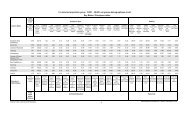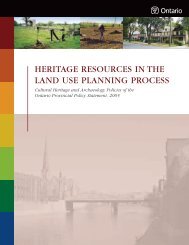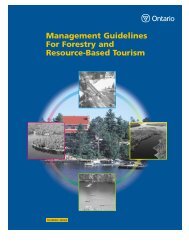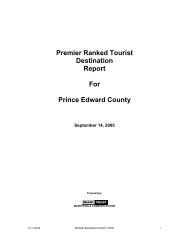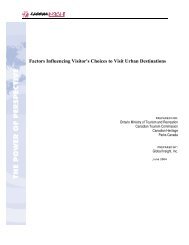Cultural Heritage Resources - Ministry of Tourism
Cultural Heritage Resources - Ministry of Tourism
Cultural Heritage Resources - Ministry of Tourism
Create successful ePaper yourself
Turn your PDF publications into a flip-book with our unique Google optimized e-Paper software.
TABLE OF CONTENTSIntroductionPart 1: Information for Applicants – not included in posting –Part 2: Guidance for Conducting the <strong>Heritage</strong> Assessment2.1: Key Terms2.2: Investigation2.3: Evaluation2.4: Impacts and Mitigation2.5: <strong>Heritage</strong> Assessment Report ComponentsAppendix E: Evaluation <strong>of</strong> <strong>Heritage</strong> <strong>Resources</strong>2
PART 2GUIDANCE FOR CONDUCTINGTHE HERITAGE ASSESSMENT4
2.1: Key TermsThis section provides further detail on some <strong>of</strong> the important terms in section 23 <strong>of</strong> O.Reg. 359/09.Section 23 <strong>of</strong> O. Reg. 359/09 outlines therequirements <strong>of</strong> the heritage assessment. Theheritage assessment must include historicalresearch and a visual inspection to determinewhether there is potential for heritageresources, or abutting protected properties.Below are some <strong>of</strong> the key terms and conceptsthat will be relevant to this report. Please note thatthe assessment should be conducted by aqualified person, and the report must provide asummary <strong>of</strong> the qualifications and experience <strong>of</strong>the person(s) who conducted the assessment andprepared the report.<strong>Heritage</strong> <strong>Resources</strong>Under O. Reg. 359/09 a heritage resource refersto real property that is <strong>of</strong> cultural heritage value orinterest and may include a building, structure,landscape or other feature <strong>of</strong> real property.Generally speaking, heritage resources would bedivided into built heritage resources and culturalheritage landscapes. Of particular importance forconsideration within the context <strong>of</strong> renewableenergy projects is the inter-relationship between abuilding, structure or ruin with the surroundinglandscape including significant views from and <strong>of</strong>the heritage resource.Consideration <strong>of</strong> all heritage resources includesresources that have not yet been identified assignificant, that are identified through the research,evaluation and assessment process. It alsoincludes resources that have been previouslyidentified or commemorated by the community,province or in the national context (e.g., a propertythat is listed on the municipal register, identifiedwith a local plaque, included on a local walkingtour, the subject <strong>of</strong> a provincial plaque, ordesignated a National Historic Site).Built <strong>Heritage</strong> <strong>Resources</strong>:Examples <strong>of</strong> built heritage resources include:residential structures, farm buildings, mills,industrial, commercial, institutional buildings,bridges, water systems, dams, canals, locks,cairns, statues, monuments, fountains, retainingwalls, boundary or claim marker, or ruins.<strong>Cultural</strong> <strong>Heritage</strong> Landscapes<strong>Cultural</strong> heritage landscapes provide the context,setting or support for the character <strong>of</strong> an area.<strong>Cultural</strong> heritage landscapes are groupings <strong>of</strong>buildings, structures, spaces, archaeologicalsites, and/or natural elements that collectively aresignificant or representative. Examples include:burial sites, cemeteries, historic roadways, railcorridors, waterscapes, historical settlements,battlefields, streetscapes, agricultural landscapes,a park or designed recreational community space,or a heritage conservation district.The following definitions <strong>of</strong> cultural heritagelandscapes are taken from the OperationalGuidelines adopted by the United NationsEducational, Scientific and <strong>Cultural</strong> Organization(UNESCO) World <strong>Heritage</strong> Committee in 1992,and are widely accepted as the three primarylandscape types:Designed landscapes: those which have beenintentionally designed (e.g., a planned gardenor downtown square).Evolved landscapes: those which haveevolved through use by people whoseactivities have directly shaped the landscapeor area. This can include continuing orongoing use, or a relict landscape where theevolutionary processes has come to an end(e.g., an abandoned mine or historicalsettlement area).Associative landscapes: those with powerfulreligious, artistic, or cultural associations <strong>of</strong> thenatural element, as well as with materialcultural evidence (e.g., a sacred site within anatural environment or an historic battlefield).These landscapes may have material culturalevidence or material culture may be absent.Abutting Protected PropertiesProperties that share a common boundary orborder, or overlap for some distance areconsidered abutting. For the purposes <strong>of</strong>renewable energy projects, the term ‘abutting’ also5
includes parcels <strong>of</strong> land that are separated by anintervening road allowance, trail, etc.Project LocationO. Reg. 359/09 requires consideration <strong>of</strong> heritageresources at the project location. Projectlocation is defined as a part <strong>of</strong> land and all or part<strong>of</strong> any building or structure in, on or over which aperson is engaging in or proposes to engage inthe project and any air space in which a person isengaging in or proposes to engage in the project.This includes all land, buildings or structures whichmay be impacted by activities for all projectphases (i.e. the construction, installation,operation and use, changing or retiring <strong>of</strong> thefacility).Study AreaAs the project location may be situated within acultural heritage landscape, for the purposes <strong>of</strong>the heritage assessment MTCS recommends thatthe qualified person consider the whole property(or properties) on which project components arelocated. Assessing a cultural heritage landscapeinvolves looking beyond the footprint <strong>of</strong> the projectand analyzing the surrounding area. As culturalheritage landscapes are included in the definition<strong>of</strong> ‘heritage resource’, defining a broader studyarea is an important step in determining impacts tothis type <strong>of</strong> heritage resource.ImpactsEvaluating impacts can be broadly defined as theprocess <strong>of</strong> identifying, predicting, and evaluatingthe cultural, biological, physical, social and otherrelevant effects <strong>of</strong> the renewable energy project.With respect to a renewable energy project,alteration refers to the erection or construction <strong>of</strong>project components on the property which mayimpact views and vistas, alter the existinglandscape, require demolition <strong>of</strong> existing buildingsor structures, or have other impacts on heritageresources. Project components include not onlyprimary elements such as wind turbines or solarpanels, but also secondary elements such asaccess roads, laydown areas, etc.Impacts can be temporary (e.g., dust and vibrationduring construction) or longer term (e.g., visualintrusions <strong>of</strong> new or modified infrastructure). Theheritage assessment report must identify anddescribe the extent <strong>of</strong> all potential impacts;describe how each identified heritage resourcemay be impacted with reference to the specificcultural heritage value <strong>of</strong> the resource; andexamine mitigation options and project changes toprevent or reduce negative impacts. Finally, theheritage assessment report must recommend amitigation option and explain why it is preferred.Additionally, assessing a larger study area is abest practice that encourages identification <strong>of</strong>heritage resources early in the design phase andallows for a broader range <strong>of</strong> options for avoiding,eliminating or mitigating impacts. This approachprovides proponents with greater flexibility shouldthey have to alter the project layout either becauseadditional environmental constraints are identifiedat a later stage, or as a result <strong>of</strong> the consultationand engagement process.6
2.2: InvestigationThis section provides guidance on how to conduct an investigation, including historicalresearch and visual inspection.There are five steps involved in undertaking a siteinvestigation:1. Identify the study area.2. Consult with municipal staff, Aboriginalcommunities, heritage organizations and thepublic to learn more about the cultural heritage<strong>of</strong> the community.3. Apply preliminary criteria to screen for knownand potential heritage resources and createan inventory.4. Analyze inventoried resources through a sitevisit.5. Investigate inventoried resources throughfurther historical and archival research,historical maps, municipal records andinterviews.1) The Study Area:For the purposes <strong>of</strong> the heritage assessment,considering a larger study area is a recommendedbest practice. The study area may be defined asthe geographic area that may be altered orimpacted because <strong>of</strong> the proposed project.The nature <strong>of</strong> the existing terrain, land elevations,vegetation, waterways, roadways, rail corridors,protected properties and known heritageresources, along with any other relevantenvironmental factors should be considered whendefining the study area. The study area andproject location should be clearly depicted on amap that is included in the final report.2) Community Input:Under O. Reg. 359/09, the applicant is required toconsult with the public, municipalities, andAboriginal communities regarding the proposedproject. The person conducting the heritageassessment should make their best efforts toensure that any heritage concerns brought forwardduring early public meetings and through anyengagement with Aboriginal communities areincorporated into the heritage assessment.Proactive engagement with community memberscan save the proponent from having to makecostly alterations to project layouts if a heritageconcern is brought forward at the final publicmeeting, or after the application is submitted toMOE.<strong>Heritage</strong> and archaeological sites are <strong>of</strong> criticalimportance to First Nations, Métis and Inuitcommunities. Aboriginal communities may haveinformation about heritage sites that are <strong>of</strong> specialimportance to their community and should beinvolved in the assessment process. Informationabout cultural heritage resources should berequested during the formal Aboriginalengagement process. Please note that traditionalknowledge may be considered sensitive. Forfurther information on engaging Aboriginalcommunities please see MTCS’ Draft TechnicalBulletin: Engaging Aboriginal Communities inArchaeology. Although this document refersspecifically to archaeology, it provides generalbackground material on effective approaches toengaging with Aboriginal communities overall.Municipal staff will be a helpful resourcethroughout the identification and evaluationprocesses. If the municipality has a municipalheritage planner and/or a Municipal <strong>Heritage</strong>Committee (MHC), they should be contacted whenconducting the heritage assessment. The localcommunity may also have a historical society,heritage museum, Architectural Conservancy <strong>of</strong>Ontario (ACO) local chapter, or other localheritage interest groups that may be consulted.Information can also be gathered from localheritage groups, librarians, museum curators andhistorians, as well as published local histories.These sources will help to establish thecommunity context and identify historical themesthat can be used in screening for potential heritageresources. Community members may also directthe qualified person to important heritageresources that are not easily identifiable througharchival sources or site visits.The objective <strong>of</strong> consulting with interestedindividuals and groups is to identify all potentialand known cultural heritage resources that may beaffected by the proposed development. Engaginginterested parties early in the heritage assessmentprocess can help to ensure that review is not
delayed. Efforts to conduct interviews and theinformation gathered in the interviews should bedocumented in the heritage assessment report.Under O. Reg. 359/09, the municipality in whichthe renewable energy project is to be located isrequired to identify any heritage or archaeologicalresources at the project location on theirMunicipal Consultation Form, which is submittedto MOE in keeping with the consultationrequirements for REA. The person conducting theheritage assessment should make a best practice<strong>of</strong> reviewing this document to ensure that allheritage resources indicated by the municipalityhave been addressed in the heritage assessmentreport.For more information please refer to MOE’sTechnical Guide to Renewable Energy Approvalswhich provides guidance on preparing theconsultation report, and MOE’s Draft AboriginalConsultation Guide.3) Screening and Inventory:Conducting a screening and preparing a culturalheritage inventory is an important step in theheritage assessment process. The principleobjective <strong>of</strong> the screening is to take stock <strong>of</strong> allknown and potential heritage resources and toidentify the number, type, and location <strong>of</strong>buildings, structures, landscapes and/or featuresthat could be considered to be <strong>of</strong> potential culturalheritage value.The heritage assessment report should clearlyoutline the methodology used for conducting thescreening and identify preliminary screeningcriteria such as age, theme, or category (e.g., thenumber and location <strong>of</strong> farm complexes, rivers,roads or settlements).There are two types <strong>of</strong> surveys that should beconducted during the screening phase: the first isa desktop survey, which involves conductingpreliminary research using readily availablesources, such as Illustrated Historical Atlases andpublished histories. The second is a windshieldsurvey, where a large area is observed by drivingand noting particular landscapes, views, buildingsand structures within the study area.Once potential heritage resources have beenidentified, the information should be organized intoan inventory. The inventory should includephotographs and preliminary historical informationdetermined during the screening. Further researchand evaluation against O. Reg. 9/06 under theOntario <strong>Heritage</strong> Act (“Criteria for Determining<strong>Cultural</strong> <strong>Heritage</strong> Value or Interest”) is required todistinguish which <strong>of</strong> the inventoried resources areheritage resources that should be consideredfurther in the heritage assessment (see section2.3: Evaluation). A summary <strong>of</strong> all heritageresources identified at this stage should beprovided in the heritage assessment report alongwith a rationale for those resources screened outduring this step.4) Site Visit:The purpose <strong>of</strong> the site visit or windshield surveyis to record and analyze the physicalcharacteristics <strong>of</strong> the project location and todevelop knowledge <strong>of</strong> the landscape and context<strong>of</strong> the heritage resources.The qualified person should make a visual andwritten record <strong>of</strong> each building, structure orlandscape in sufficient detail to clearly illustratesignificant features. Descriptions should be clearand concise and touch on all significant features,and photographs should accompany a brief writtenpr<strong>of</strong>ile <strong>of</strong> each heritage resource. Photographsshould be cross-referenced to vantage pointsmarked on plans and should include compasspoint references for each view.Photographs <strong>of</strong> buildings and structures shouldprovide information on massing, materials,architectural features such as wall design, ro<strong>of</strong>shape, windows, property layout, principle viewsand the setting <strong>of</strong> the building and relationshipbetween the building or structure and thesurrounding landscape. For example, photographsshould show: principle elevation and at least one sideelevationperspective views <strong>of</strong> rear, front and sidegeneral view from a distance sufficient toshow setting, landscape and adjacentbuildingsif relevant, detailed views <strong>of</strong> importantcomponents such as entrances, windows,structural components, and/or technologicalfeatures such as machinery and equipmentFor landscapes, multiple views and perspectivesshould be recorded and photographed.Topography, elevations, and any significant manmadeor natural features which may provide cluesto the historical development and character <strong>of</strong> the8
area should be identified. For example,photographs should: demonstrate overall contextual views andshow the relationship and placement <strong>of</strong> siteelements show general views <strong>of</strong> features thatcharacterize the landscape show perspective views <strong>of</strong> contributingelements, buildings and structures Photographs should be taken from the nearestpublicly accessible viewpoint. For privateproperty, permission must be sought to accessthe property for the purposes <strong>of</strong> site analysisand photographic documentation.5) Historical research:In depth historical research should be conductedin order to support the identification and evaluation<strong>of</strong> heritage resources. This is particularly importantas the historical association and contextual value<strong>of</strong> a heritage resource cannot always bedetermined easily through a site visit or windshieldsurvey. Historical research involves consultingarchival records and other documentation to learnthe history and cultural associations <strong>of</strong> theproperty. This may include accessing municipaland provincial records such as land titles,municipal assessment rolls, county atlases, andfire insurance maps. Local museums, libraries andarchives are also valuable sources <strong>of</strong> information.Some <strong>of</strong> the available historical resources thatshould be consulted include: Land Registry Office records Property tax assessment rolls Illustrated Historical Atlases Survey maps and historic town plans Fire insurance mapsAerial photographsCensus recordsLocal directoriesArchival sources (e.g., newspapers, historicphotographs, postcards, business records,and family records)Local histories and secondary sourcesThe collected information should be analyzed andpresented in a written narrative <strong>of</strong> the historicalcontext <strong>of</strong> the lands on which the project is locatedas well as the surrounding area. The report shouldidentify significant patterns, events, and personshaving cultural heritage value or interest. Thehistorical research should reveal details about landoccupancy, ownership and use <strong>of</strong> the site, andsettlement and building patterns, as well ashistorical themes that may have impacted theevolution <strong>of</strong> the landscape. All historical sourcesshould be appropriately documented andreferenced.To demonstrate the value <strong>of</strong> built heritageresources and/or cultural heritage landscapes, adescription <strong>of</strong> historical development should focuson historical settlement and the industrial,commercial, political and cultural development <strong>of</strong>the area. While pre-contact and archaeologicalcontext will be described in the archaeologyassessments, this information should also bepresented in the heritage assessment if it helps toinform an understanding and evaluation <strong>of</strong> theidentified heritage resources.Archival research should be combined with a sitevisit and/or windshield survey for a full evaluation<strong>of</strong> the cultural heritage resources at the projectlocation.9
2.3: EvaluationThis section provides guidance on how to conduct an evaluation <strong>of</strong> potential heritageresources against the Criteria for Determining <strong>Cultural</strong> <strong>Heritage</strong> Value or Interest (O.Reg. 9/06) made under the Ontario <strong>Heritage</strong> Act.The findings <strong>of</strong> the historical research and siteanalysis (outlined in Section 2.2 <strong>of</strong> this Bulletin)are used to evaluate heritage resources inrelation to the criteria set out in Regulation 9/06made under the OHA. The evaluation shouldprovide sufficient information about the physical,associative and contextual value <strong>of</strong> each heritageresource located at or abutting the projectlocation to determine cultural heritage value orinterest.<strong>Cultural</strong> <strong>Heritage</strong> Value or Interest (CHVI)A resource can be said to be <strong>of</strong> cultural heritagevalue or interest if it meets one or more <strong>of</strong> thecriteria set out in O. Reg. 9/06. Potential culturalheritage resources identified during backgroundresearch and preliminary screening should bereferred to as potential heritage resources untilan evaluation against O. Reg. 9/06 determinesthey are <strong>of</strong> cultural heritage value or interest.The Criteria for Determining <strong>Cultural</strong> <strong>Heritage</strong>Value or Interest established under O. Reg. 9/06are: The property has design value or physicalvalue because it:ois a rare, unique, representative or earlyexample <strong>of</strong> a style, type, expression,material or construction method;o displays a high degree <strong>of</strong> craftsmanshipor artistic merit; oro demonstrates a high degree <strong>of</strong> technicalor scientific achievement.The property has historical or associativevalue because it:o has direct associations with a theme,event, belief, person, activity,organization or institution that issignificant to a community;ooyields, or has the potential to yield,information that contributes to anunderstanding <strong>of</strong> a community orculture; ordemonstrates or reflects the work orideas <strong>of</strong> an architect, artist, builder,designer or theorist who is significant toa community.The property has contextual value because it:o is important in defining, maintaining orsupporting the character <strong>of</strong> an area;o is physically, functionally, visually orhistorically linked to its surroundings; oro is a landmark.The evaluation form included in this Bulletin asAppendix E may be used to help to organize anddocument the evaluation <strong>of</strong> potential heritageresources against Regulation 9/06. In some cases it may be difficult to obtain therequired information (e.g., if historical recordshave been destroyed). It is important toacknowledge in the heritage assessmentreport what information was not obtainableand how the missing information may affectthe evaluation.Statement <strong>of</strong> <strong>Cultural</strong> <strong>Heritage</strong> VaIue orInterestFor any property or landscape that is determinedto be <strong>of</strong> cultural heritage value or interest, thereport should articulate how the resource meetsRegulation 9/06 in a Statement <strong>of</strong> <strong>Cultural</strong><strong>Heritage</strong> Value or Interest. The Statement shouldconvey why the property is important, explainingthose cultural meanings, associations andconnections the property holds.The Statement should clearly articulate why orwhat makes the resource significant andanticipate potential changes or alterationsresulting from the proposed project that may havean impact on the cultural heritage value <strong>of</strong> theproperty. The statement should identify theresource’s heritage attributes. <strong>Heritage</strong>attributes can be defined as the physical features,materials, forms, locations or spatial configurationsthat contribute to, support, or embody each valueand provide an explanation as to why this issignificant.10
The heritage assessment should clearly describethe relationship between heritage value <strong>of</strong> the siteor property and the identified heritage attributes.The Statement should provide sufficientinformation to explain the significance <strong>of</strong> theresource, and should be approximately two tothree paragraphs. The Statement should includebuilt, structural and landscape features, andclearly identify the resource’s physical attributesand associations, as well as the cultural meaningthat the resource holds to the community. Foreach identified value, the Statement shouldspecify the key heritage attributes that areassociated with these meanings.If, after the evaluation process, a resource is foundnot to have cultural heritage value or interest, theperson conducting the heritage assessmentshould prepare a summary statement that explainsthe conclusions and recommendations <strong>of</strong> theheritage assessment report. There should be aclear rationale made in the report specifying whyno further assessment or evaluation is required.11
2.4: Impacts and MitigationThis section provides guidance on how to identify and evaluate potential project impactsto identified heritage resources and abutting protected properties and develop mitigationor avoidance measures.Renewable energy projects have the potential toaffect cultural heritage resources in a variety <strong>of</strong>ways including loss or displacement <strong>of</strong> resourcesthrough removal or demolition and alteration <strong>of</strong>resources by introducing physical, or visualelements that are not in keeping with the heritagevalue and/or their setting.ImpactsEvaluating impacts is the process <strong>of</strong> identifying,predicting, evaluating and mitigating the cultural,physical, social and other relevant effects <strong>of</strong> therenewable energy project on heritage resources.The context and qualities <strong>of</strong> the surroundings <strong>of</strong> aheritage resource can play an important role inmodern perceptions <strong>of</strong> heritage resources and thealteration <strong>of</strong> those qualities has the potential toadversely affect the cultural heritage value <strong>of</strong>heritage resources. A renewable energy projectmight not have a direct physical impact on culturalheritage resources on or abutting the projectlocation, however there may be a wide range <strong>of</strong>impacts to the visual and contextual relationshipbetween the heritage resource and itssurroundings.Examples <strong>of</strong> impacts <strong>of</strong> renewable energy projectson heritage resources include (but are not limitedto):Destruction Destruction or removal <strong>of</strong> any, or part <strong>of</strong> any <strong>of</strong>the identified heritage attributes.Alteration Alteration <strong>of</strong> a building, structure or landscapein a manner that is not sympathetic, or isincompatible with the historic fabric andappearance. Vibration damages to a structure or buildingduring construction or because <strong>of</strong> changes toadjacent land use. Introduction <strong>of</strong> elements that visually orphysically diminish the heritage value <strong>of</strong> alandscape, structure or building.Shadows Shadows that alter the appearance <strong>of</strong> aheritage attribute or change the visibility <strong>of</strong> anatural feature.Isolation Reduced accessibility to landmark, monumentor public site. Change in relationship or isolation <strong>of</strong> aheritage attribute or resource from itssurrounding environment or context.Obstruction Obstruction <strong>of</strong> significant views from or <strong>of</strong> abuilt heritage resource or a cultural heritagelandscape. Obstruction through the rerouting <strong>of</strong> traffic,alteration <strong>of</strong> roadways or gateways near alandmark that limit access to a resource orproperty.Change in Use Change <strong>of</strong> use or neglect <strong>of</strong> a heritageresource which causes deterioration <strong>of</strong>heritage attributes.Land disturbances Widening <strong>of</strong> existing rural roads, introduction<strong>of</strong> new roads, and/or removal <strong>of</strong> plantings, etc. Land disturbance, such as a change in gradethat alters historical patterns <strong>of</strong> topography ordrainage.If a proposed project will not affect the attributesthat embody the cultural heritage value <strong>of</strong> aresource, it is generally understood that a finding<strong>of</strong> no impact is appropriate; however the reportshould demonstrate how this conclusion wasreached for each identified heritage value.MitigationThe heritage assessment report must providerecommendations including mitigation options andconservation strategies to avoid or reduceimpacts. The heritage assessment report should12
include a rationale for why the proposed mitigationis the best possible solution and why otheralternatives are not viable (e.g., perhaps otherenvironmental constraints limit potential mitigationoptions).Mitigation may include, but is not limited to thefollowing: impacts are avoided and project componentsand construction activities are distanced fromheritage resources mitigation through design, or alternativedevelopment approaches sympathetic alteration that respects theheritage attributes <strong>of</strong> the cultural heritageresource alterations or new construction that arereversible physical and visual compatibility with theexisting cultural heritage resource layout or component design alternatives thatminimize visual intrusions separation distances or compatible visualbarriers specified to avoid or reduce visualimpact to the identified heritage resource introduction <strong>of</strong> sympathetic plantings,materials and features where no in-situ conservation option isfeasible, moving and/or relocating a builtheritage resource interpretation and commemoration (whererelevant)If heritage attributes are to be removed or theheritage resource is to be demolished, theheritage assessment report must include therationale for removal and the process fordocumentation <strong>of</strong> pre-existing conditions (e.g.,photographs, measured drawings and salvagematerials).If long-term protection <strong>of</strong> a heritage resource isproposed, the heritage assessment report mightrecommend that a heritage conservation plan bedeveloped. The conservation plan, preparedseparately as a condition <strong>of</strong> approval, should be astand-alone document with a defined purpose,tailored to the heritage resource being conserved.The objective <strong>of</strong> a conservation plan is to set out astrategy for managing and conserving the heritageattributes <strong>of</strong> a resource over the long term. Itshould provide the owners and managers <strong>of</strong> theheritage resource with useful tools and advice forongoing management <strong>of</strong> the resource. Theheritage assessment report should include therationale for recommending a conservation planover other mitigation strategies.Where the effect <strong>of</strong> proposed work is likely tonegatively impact the cultural heritage value <strong>of</strong> aresource, each negative impact should beidentified with a statement as to why they couldnot be avoided.13
2.5: Preparing the <strong>Heritage</strong> Assessment ReportThis section provides advice on report components that will support the findings in aheritage assessment report.The heritage assessment report should includea general description <strong>of</strong> all project components,including facilities, operational equipment,construction equipment and activities, and allpermanent and temporary structures, associatedwith infrastructure (e.g., transmission componentsand transformer areas). The report should alsoinclude descriptions and rationale for thedevelopment or site alteration, for the proposedworks and graphical layout, and for how thedevelopment or alteration fits within thecontext/landscape <strong>of</strong> the study area. Supportdocuments should include: a map showing the project location, theproject layout, and the study area. a map showing project components in relationto identified heritage resources. drawings and schematics <strong>of</strong> all major projectcomponents to show their size and scope.The heritage assessment report should include asummary <strong>of</strong> the qualifications and experience <strong>of</strong>the qualified person who conducted theassessment. It should also include summaries <strong>of</strong>the qualifications and experience <strong>of</strong> all members<strong>of</strong> the project team.Study AreaThe heritage assessment report should provide adetailed description <strong>of</strong> the study area in relation toconstruction and site alteration activities, anyproject components, setbacks, roadways,temporary access roads, laydown areas, location<strong>of</strong> identified heritage resources and/or associatedattributes such as significant vistas and views.Maps that clearly define the study area, projectlocation (including any and all project componentssuch as access roads, laydown areas andequipment), as well as any heritage resourcesidentified within the report are required. Mapsmust include a title, scale, north arrow and legend.Using maps, photomontages, and writtendescriptions, the heritage assessment reportshould describe the relationship between projectcomponents, heritage resources and abuttingprotected properties identified in the study area.Identification <strong>of</strong> Potential <strong>Heritage</strong> <strong>Resources</strong>The report must include a summary <strong>of</strong> howheritage resources were identified and themethodology used for screening. The summaryshould include an inventory <strong>of</strong> potential heritageresources, with a rationale for any propertiesscreened out at this phase. Specifically, thissection <strong>of</strong> the report should include: A description <strong>of</strong> any potential built heritageresources and structures that may beimpacted. The description should coverlocation and function, building materials,architectural finishes and design elements,setting, landscape and context. A description <strong>of</strong> any potential cultural heritagelandscapes, views and vistas that may beimpacted. The description should cover thephysical characteristics <strong>of</strong> the property orproperties including site layout, plantings andhistorical landscape elements. Photographs and written summaries <strong>of</strong>potential heritage resources and landscapesfrom site visits.Summary <strong>of</strong> researchThe report must include a summary <strong>of</strong> thehistorical research, consultation and communityengagement undertaken in order to determinecultural heritage value. The heritage resource orlandscape and its setting should be defined insufficient detail for the reader to know the locationand understand the references in the othersections <strong>of</strong> the plan. Support materials mightinclude: historical maps, plans, drawings andillustrations historical and current photographs aerial photographs14
Evaluation <strong>of</strong> <strong>Heritage</strong> <strong>Resources</strong>The report must include a description <strong>of</strong> theevaluation <strong>of</strong> each heritage resource against each<strong>of</strong> the criteria in Regulation 9/06. The summaryshould include: a written and visual documentation <strong>of</strong> thephysical context <strong>of</strong> the project includingabutting properties; analysis <strong>of</strong> relationship <strong>of</strong> the heritageresource(s) to its surroundings, includingprincipal views to and from the property; and a Statement <strong>of</strong> <strong>Cultural</strong> <strong>Heritage</strong> Value orInterest that identifies key heritage attributesfor each confirmed resource.Evaluation <strong>of</strong> ImpactsThe report should include a description <strong>of</strong> allpotential impacts to confirmed heritage resourcesand abutting protected properties with reference tospecific heritage attributes. Supporting materialmay include: visual simulations, renderings, diagrams, photomontages and visual analysis documentation to support analysis <strong>of</strong> impactsMitigation StrategiesThe report should include a summary <strong>of</strong> proposedalternatives and mitigation and conservationstrategies where an impact on a heritage resourcehas been identified. These alternatives should bediscussed with the project proponent and apreferred alternative selected.The summary should clarify why a particularconservation, mitigation measure or alternativedevelopment approach is the preferred way toconserve the heritage resource(s) within thecontext <strong>of</strong> the proposed development. Supportmaterials such as photographs, photomontagesand aids should be provided in support <strong>of</strong> thepreferred approach.MTCS encourages in-situ conservation <strong>of</strong> heritageresources where possible. This includes themaintenance <strong>of</strong> all identified heritage attributesincluding physical features, significant views andcontextual setting. Only when this option is notavailable should other alternatives be considered.ReferencesA bibliography listing all source materialsreferenced in the heritage assessment should beappended to the report, and citations should beincluded where appropriate. If personalconversations were used as a source, theparticipants' positions and the time, place andtheme(s) <strong>of</strong> the conversation(s) should be listed,as should any institutions/organizations that wereconsulted.New Information and Project ChangesIt is possible for new information or projectchanges to arise after the heritage assessment iscomplete and the report submitted to MTCS forreview. The applicant should discuss thisinformation or changes with the person preparingthe report to determine if any additionalassessment or reporting is required.SummaryOverall the heritage assessment report should: demonstrate early identification, considerationand management <strong>of</strong> heritage resourcesthroughout the decision-making process; describe efforts to engage the community,Aboriginal communities, municipal staff,heritage groups, etc; demonstrate consideration <strong>of</strong> community andAboriginal input; demonstrate consideration <strong>of</strong> resources in thecontext <strong>of</strong> the community and surroundingarea; encourage approaches to planning that aresustainable and minimize negative long-termimpacts on the social, cultural, economic andphysical aspects <strong>of</strong> heritage resources; demonstrate consideration <strong>of</strong> the significance,type, use and condition <strong>of</strong> a resource andrecommend changes that will <strong>of</strong>fer the leastharm to the resource, or will provide thegreatest potential to enhance its significanceand appreciation; and demonstrate that the design <strong>of</strong> the project hasavoided or minimized impacts to heritageresources where possible.15
Appendix E: Evaluation <strong>of</strong> <strong>Heritage</strong> <strong>Resources</strong>The chart below outlines some <strong>of</strong> the key information that the qualified person should consider when evaluating aresource for cultural heritage value or interest:Property descriptionLocation/contextAbstractDocumentation dateUse (original and current)Major historical themesDocumented discrete componentsDiscrete elements requiring independentevaluation.EvaluationThe evaluation criteria presented below reflectOntario Regulation 9/06 Criteria for Determining<strong>Cultural</strong> <strong>Heritage</strong> Value or Interest, under theOntario <strong>Heritage</strong> Act.YUNThe property satisfies the criterion.There is insufficient information to know whether or how the property satisfies the criterion.The property does not satisfy the criterion.1. The property has does not have design value or physical value.i. It is a rare , unique , representative orearly example <strong>of</strong> a style, type, expression, materialor construction method described below.Y – U – NNote to evaluator(s): In the Frame <strong>of</strong> reference line, briefly describe the physical and historical context within which the rarity or representativeness <strong>of</strong> the property isbeing considered.StyleUse (Original and Current)ExpressionMaterial(s)Construction methodFrame <strong>of</strong> referenceii. It displays a high degree <strong>of</strong> craftsmanship and/orartistic merit .Y – U – N16
iii.It demonstrates a high degree <strong>of</strong>technical or scientific achievement.Y – U – N2. The property has does not have historical value or associative value.i. It has direct associations with a theme , event ,belief , person , activity , organization orinstitution that is significant to a community.Community <strong>of</strong> interestii. It demonstrates or reflects the work or ideas <strong>of</strong> anarchitect , artist , builder , designer ortheorist who is significant to a community.Community <strong>of</strong> interestiii. It yields , or has the potential to yield ,information that contributes to an understanding<strong>of</strong> a community or culture.Community or cultureY – U – NNote to evaluator(s): In the notes below, provide brief details about the theme, event, etc.notes:International , National , Provincial , Regional , Local , Aboriginal , Other community(identify)_________________________Y – U – Nnotes:International , National , Provincial , Regional , Local , Aboriginal , Other community(identify)_________________________Y – U – Nnotes:Local , Aboriginal , Other community (identify)_________________________3. The property has does not have contextual value.i. It is important in defining , maintaining orsupporting the character <strong>of</strong> an area.Y – U – NNote to evaluator(s): In the Context line, briefly describe the physical context within which the property is being considered.Contextii. It is physically , functionally , visually orhistorically linked to its surroundings.Y – U – NContextiii. It is a landmark.Y – U – NContextGeneral ratingFor a heritage resource to merit recognition as having“cultural heritage value” it must get a positive answerin at least one <strong>of</strong> the three categories.G1‐physical—G2‐associative—G3‐contextual—Evaluation summaryJudged to have cultural heritage value(in at least one <strong>of</strong> the three categories)Draft statement <strong>of</strong> cultural heritage value and description <strong>of</strong> heritage attributes.Assessed to have notable culturalheritage value (positive answers in twoor more categories)INAPPLICABLEAssessed to have no definitive culturalheritage valueProject Name:17


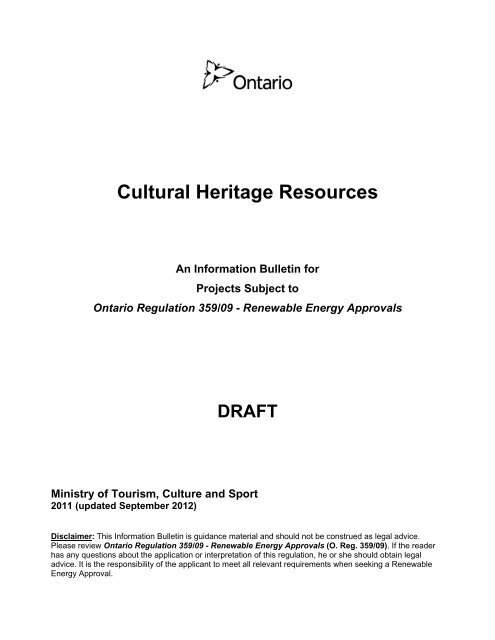
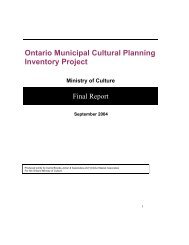
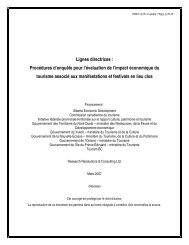
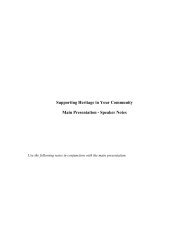
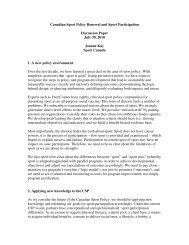
![THIS AGREEMENT made this [date], between [name of owner] (the ...](https://img.yumpu.com/49827605/1/158x260/this-agreement-made-this-date-between-name-of-owner-the-.jpg?quality=85)

